When language is misused, people tend to get confused.
And, misled.
One example of this is the way “4WD” is now being regularly used to describe that which isn’t. Or rather, wasn’t – historically speaking.
Before the rise of the Universal Transportation Appliance, the car-based crossover “SUV” (in air fingers quotes because that’s another example of semantic abuse) a 4WD-equipped vehicle was one that had a truck-type system, based on a rear-wheel-drive layout with a two speed transfer case and Low range gearing.
The system normally routed all of the engine’s power to the rear wheels only, in 2WD High. When 4WD High was engaged, the power was split 50-50 front to rear. In 4WD Low, the gearing was altered to greatly multiply the available leverage, for force-fording through deep snow or thick mud, etc.
Obviously, these attributes are desirable – if you need or want to force-ford your way through deep snow or thick mud, etc.
The problem is that the typical Universal Transportation Appliance – the crossover “SUV” – doesn’t have them.
What the UTA generally has – because of what it is – is an all-wheel-drive (AWD) system, which s not the same thing as a 4WD system.
Enter the confusion.
Easily done, too.
Because – technically speaking – AWD is 4WD in that it is true that all four wheels are driven. But it is also as misleading as saying you’ll save “up to” such and such a sum if you buy X to say that AWD is the same as 4WD.
Because it ain’t.
Most AWD systems, to begin with, are front-drive-based and in normal driving situations send all or nearly all of the engine’s power to the front wheels only.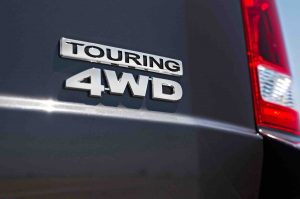
This is actually a benefit, by the way – in terms of initial traction/grip – because you’re less apt to experience slip when the car pulls itself forward than pushes itself forward. The first production FWD car – the Citroen Traction Avant of the ’30s – touted just that.
The name means traction forward.
Generally speaking, FWD can obviate the need to buy a 4WD-equipped vehicle – in that a FWD car (or UTA) will have more grip on a wet or snow-slicked road than a rear-drive car or a 4WD vehicle that’s operating in 2WD High (which is rear-drive, only).
The AWD system also automatically routes a certain amount of engine power to the rear wheels without the driver having to engage anything. In most 4WD systems, the driver must engage the 4WD to get 4WD (some of the newer systems do this automatically, furthering the confusion).
The AWD system can continuously vary the power split, front to rear – by as much as 100 percent in either direction, based on whether the front or rear wheels have the most grip.
Most 4WD systems lock the split, 50-50 as described above.
AWD can actually provide more traction on wet/snow-slicked roads.
It also confers a lateral traction advantage that 4WD does not. What’s meant by that is simply that most AWD systems can tailor-adjust wheel slip from side to side as well as front to rear; this capability – in conjunction with ABS application of the brakes – can be used to greatly increase high speed cornering grip/stability on dry (as well as wet/snow-slicked) pavement.
It is why many high-performance cars are equipped with AWD rather than 4WD.
Most 4WD systems do not enhance high-speed handling tenacity and – indeed – it s not advisable to engage the 4WD unless there is snow on the road – or you are off the road.
And to not be going fast, in the curves.
The reason for that being the differential in rotational speeds of the inside and outside wheels during cornering. This can bind the axles up and cause mechanical problems/premature wear of the components.
So, slow down when the 4WD is on.
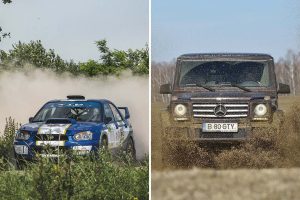
But, 4WD systems – as historically defined – have that two-speed transfer case and the gear-reduction functionality that endows them with greater low-speed force-fording capability in very low traction situations, such as slogging through deep, unplowed snow or mud, off road. Some AWD systems emulate this functionality by using their transmissions to multiply the effective gearing and they can be quite capable, too.
But they aren’t as rugged.
Because they are not built as heavily, usually. The cases and what’s in them generally aren’t as sturdy and not designed to handle very high-load situations as well as 4WD systems, which are – which were once commonly understood to be – truck-type systems rather than passenger car-type systems.
Which brings us to the other semantical thing – this confusing overlap between SUV and crossover.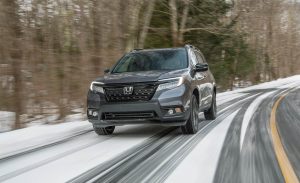
When 4WD badges were applied to the tailgates of trucks, SUVs were based on trucks. The former bed was enclosed, so as to carry more people than 4×8 sheets OSB. But underneath the floorpans, it was still all truck.
Crossovers look like SUVs but are based on cars.
Usually – though not always – front-wheel-drive cars. It is why most crossovers have or offer AWD rather than 4WD – even if that’s not what it says on their liftgates.
If you go by historically accepted definitions.
But those definitions have also been obscured by referring to crossovers as SUVs – which they aren’t.
It’s not that one or the other is better – or worse. It’s that they are not the same.
Buyers would be better served if they understood what they were looking at buying, which used to be much clearer when there were 4WD-equipped SUVs and pickups – and AWD meant something else.
. . .
Got a question about cars, bikes, Libertarian politics – or anything else? Click on the “ask Eric” link and send ’em in! Or email me at [email protected] if the @!** “ask Eric” button doesn’t work!
If you like what you’ve found here please consider supporting EPautos.
We depend on you to keep the wheels turning!
Our donate button is here.
If you prefer not to use PayPal, our mailing address is:
EPautos
721 Hummingbird Lane SE
Copper Hill, VA 24079
PS: Get an EPautos magnet or sticker or coaster in return for a $20 or more one-time donation or a $10 or more monthly recurring donation. (Please be sure to tell us you want a magnet or sticker or coaster – and also, provide an address, so we know where to mail the thing!)
My eBook about car buying (new and used) is also available for your favorite price – free! Click here. If that fails, email me at [email protected] and I will send you a copy directly!


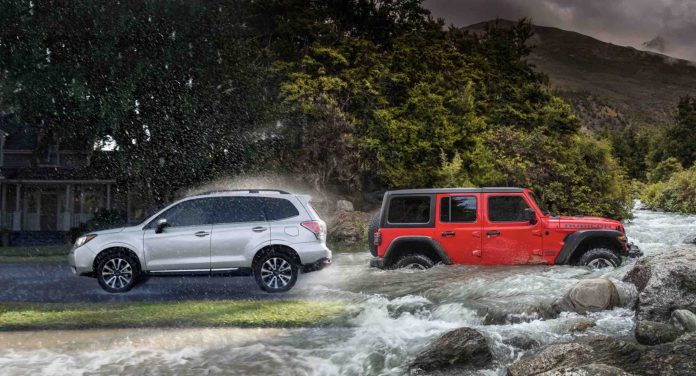

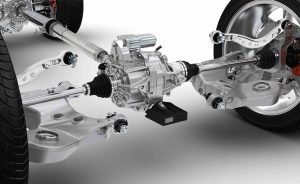








For my type of driving the 4WD in my 2012 RAV4 V6 is ideal. It’s automatically in 4WD until 25mph is reached and then disengages. Even in dry weather it’s useful for fast acceleration from rest – no wheel spin. Faster non-4WD/AWD vehicles can’t keep up – until traction is gained.
Dodge to kill Hellcat platform in ’23, replace with EV
https://www.motorauthority.com/news/1134248_dodge-boss-hellcats-dead-after-2023-drivable-2024-electric-muscle-car-concept-coming-in-2022
Hi X,
Yup. The fags won this one. No offense meant to otherwise ok gay people.
I have a 2018 4Runner TRD ORP. Prior to that I have owned Jeeps and trucks. Atrac, Locking differential, crawl control, muti-terrain select give the 4runner a huge advantage over my 97 Wrangler. Wrangler 2door was very fun to off road, Grand Cherokee was a great grocery getter but not really capable off road esp in mud. IMO, the 4runner is underpowered like others due to advancing CAFE BS, but it does really well in the South. Orange dirt that turns into orange tire sucking mud. I suspect 4WD will be rare or special order in the coming years for many reasons. 2020 and 2021 4runner models have the “Nanny” crap installed so I think I bought at the right time.
I’ve got an 80s Land Rover Defender – is it AWD or 4WD? The transfer case is mechanical, all axles are engaged at all times, and is differentiated (with limited slip) between the front and rear. The transfer case has two speeds and the ability to be locked. There is no 2WD mode.
Hi Michael,
Your LR has full-time 4WD; high and low range gearing.
Those 4WD trucks traditionally had a major failing: if one wheel spun, then 100% of the power went to that wheel, instead of to the wheels that had traction. Modern traction control systems avoid that.
Some of the old trucks had limited-slip rear differentials, or you could climb out into the mud to lock in the front hubs. There was also “Po-boy Posi-Trac”, where we would gradually apply the emergency brake to force power to the rear wheel that wasn’t slipping.
All that worked fine, as long as you were in sloppy conditions. The moment all four wheels grabbed firmly, everything would bind up, and steering took herculean effort.
Were those systems truly more durable? I doubt it. Trucks of that era were generally beat to hell by 60k, and scrap by 100k.
Also a note about low range: I recall some 30-40 years ago, an automotive magazine did an engine braking test. They had the usual line of 4WD trucks (including Jeep), pointed them down a seriously steep slope in the lowest possible gear, and let them idle down. Longest time wins.
A couple of the less serious models with had to smoke the brakes to avoid hitting dangerous speeds.
And then there was the Unimog. Yes, they brought in a ringer.
The Mog’s lowest range was so low that it was boring. Drive a stake in the ground to see if it’s moving. Get out and run laps to stay awake. Read ‘War and Peace’, then get a head start on Les Miserables.
Kind of rare that I even engage my 4×4.
I drive in the snow until I can’t, or can’t steer, then use it.
I guess that’s an advantage of learning how to drive in 70’s RWD boats in the snow.
A buddy was following me up a slick, muddy dirt hunting road and his hyundai AWD got stuck at the bottom of a trough. That thing just momentum drifted sidways until he caught onto a patch of grass.
I didn’t even engage the 4×4. Guess having decent tires is a plus too.
Which brings me to 1) know how to drive in the bad stuff & 2) get rid of those highway tires made for gas mileage & not traction.
Our Subaru Outback has AWD, but it’s damn good. No low range, so no crawling or mud, but coupled with some good snow tires (Blizzaks), we’ve gone through some pretty epic snow storms in the sierras without issue. I still remember driving up a slippery hill that was quite a challenge to maintain control, where 4WD SUV’s with inadequate tires were just sliding down sideways. It was a bit of playing dodge with sliding cars, but the Subie made it. It’s got full time mechanical connection between all wheels and the engine.
The FWD-based AWD crossovers with three open differentials do terribly in the snow, despite “all wheel drive”, because all the torque goes to the first of four wheels that start slipping, then they use brakes to slow that wheel, and those don’t come on gently, so the next wheel breaks loose, and they use brakes on that one, so you end up with this horriffic shuddering as the ABS controller is constantly pulsating the brakes on each wheel, and if it’s too slippery, you bog down the engine with your own brakes – and everything gets damn hot.
Subarus have a rear wheel drive bias, as opposed to front wheel drive bias in the transaxle models. The drive train is also more robust. If I got a notion to drive any one of them off road, it would be a Subaru.
Couple of points to consider, in agreement with the article, but some subtleties: The 4wd in trucks, really isn’t meant to go beyond speed of 25 to 30mph or so. So then for 4wd trucks, you’re (pardon the pun) stuck with 2wd and no weight over the rear wheels for road speeds, say, while in the snow. Therefore, you must be on guard! I think that is the vast majority of driver errors seeing the SUV’s and pick up trucks in ditches on snowy days… Back in my old 2wd S-10 days, I would throw 100+lbs over the rear axle when the weather was forecast to be bad. Having a 4wd truck today doesn’t get me outta that.
AWD is far superior for road travel and (decent) dirt run travel vs 4wd. This is b/c it kicks in when sensing wheel slippage, with either an electronic or (better) hydraulic center differential. I had an old 95 Subaru with a (better still!) *mechanical* center differential and you could not get that thing stuck in the snow! Limiting factor was snow depth, as the car would belly up w/tires losing contact. My ’05 Subaru has a hydraulic center differential. (The brand new ones are electronic, of course…) The ’05 has never gotten stuck either. Seen youtube videos of Sub’s vs others with Sub’s plowing thru the adverse conditions. My assessment is that the Subaru AWD systems cant be beat. (Maybe Quattro comes close..)
Lastly, I cant believe how low the front is on my 20 F150 4wd. (Done for fuel economy reasons, I’m sure) I do get good mpg’s (21+ on the road, 2.7L ecoboost). And that the stock tires are good for the road, and any manicured dirt roads. When comes time to replace, I’ll choose a more aggressive tread pattern, and raise the front end by 2″ or so.
I’d posit that most people who buy 4WD don’t actually need it & have fallen for clever marketing. If there were still locking hubs instead of push button, the masses would never risk getting their birkenstocks muddy to engage 4WD.
Indeed, vacuum or electrical hub locks will fail. Never seen or heard of manual locks failing. They may get hard to operate, but by no means impossible. As far as those who don’t need it but have it goes, sorry about the teeny weenie.
Funny- We have all of these terms today which never used to exist- SUV, crossdresser, minivan, hybrid, EV, but less actual choice when it comes to style, engine size, transmission type, options, and most of all: size- as there is no longer much if any difference between the size of a Cadillac and a Honda….
And they. all. look. the freaking same!
No wonder the current generation aren’t interested in cars….there’s nothing about cars that is interesting anymore- unless one is into performance- in which case the requisite cars are either too expensive, or made by Chrysler, and thus fall apart by the time they are on the used market.
Yes, we had more choices with framed cars even within a model let alone a brand. You often had with a single model, a choice of a four door sedan, a two door coupe, a station wagon, and often a convertible!
When my grandpa bought his last car, a Chevelle (which ended up being my first car) he had the choice of a V6, two choices of a small block V8 and two choices of a big block V8 (he chose the 305 small block)! I still have the order sheet for that car, though the car is no more 🙁
The unibody cars were supposed to create MORE choices than the framed, but of course that didn’t happen. Now you get a four door, maybe a choice of a hatchback, with a turbo 4……even the options are pretty limited by the trim level.
My 4WD has a lock up front axle, and if you aren’t careful, it will cause you to drive right into the ditch. It will go through snow as deep as the front bumper, just so you don’t need precision steering.
I have a ’73 CJ5 and an ’84 F-150 both with 4WD. I wonder if there are any vehicles still made with locking hubs and a transfer case that is engaged manually.
Most people never drive their AWD SUV hard enough for it to matter if it has AWD or not. And when they get themselves in a situation it is nearly always driver error that puts them in the ditch, not the vehicle. But either way, having a good set of snow tires will improve bad weather performance more than any drive system. I had a Pontiac Grand AM, and an Audi A3 TDI (the TDI was never was available with Quattro in US). Both were fitted with high quality winter tires and I never had an issue getting through areas where 4WD pickups and AWD SUVs were stranded. I took my Cherokee (with Trailhawk package) out on the dirt with the stock tires and got myself dug in on a small patch of snow even though the vehicle has a fairly capable 4WD transfer case. After a friend pulled me out I did a little research and found out the stock Firestones are all show and no go. The replacement tires seem to do well in greasy mud and sand, but haven’t been in much deep snow yet.
If anything, AWD and antilock brakes makes them overconfident. No problem on the snow, so when they hit a spot where its packed to ice, off the road they go. My daily driver is a Miata, with Ultra High Performance all seasons on it. It does fine on snow up to about 3″, and I often drive by SUVs galore off in the ditch. I learned to drive on such, when AWD and antilock brakes did not exist. In fact, never drove AWD or 4WD until about 35 years old. So, yes, I do know how to drive on it, and how to brake on it. A very common ditching is on two lane blacktop, where the curves are banked. Go to slow and you slide off on the inside.
I understand where you are coming from, some people ignore the warning and push on when clearly they shouldn’t. But given the sheer number of SUVs on the road they are the exception. I drive nearly every weekday, often in snow and bad weather. I see a very few wrecks and/or wreckage compared to what I would expect given the horrible drivers I see. But more often they’re moving at a snail’s pace causing other drivers to tailgate and otherwise take risks they shouldn’t.
The language isn’t being “misused”, and we aren’t being “mislead”, we are being lied to. That’s what it’s called when a party tells another party a thing which is not true. Whether by “redefining” a language they have no authority to redefine, or “implying” a thing which is not true. There were 4WD SUVs long before there were AWD Crossovers. The implication they are the same is a lie. If you start regularly off roading your AWD Crossover, you likely won’t do so for long. Your owners manual very likely tells you NOT to do so.